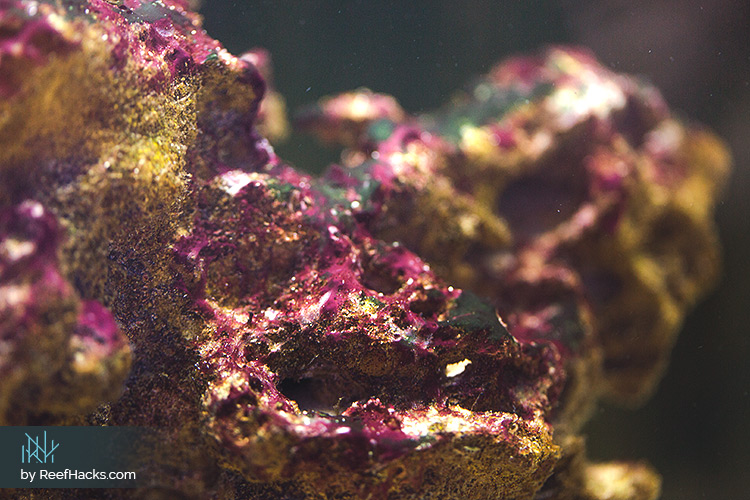A Slimy Situation Unfolds…
Ah, reef tanks. Few aquariums capture the beauty, majesty, and wonderment as these…oh wait…what’s that?
Just as you begin reveling in the magical underwater world you’ve created, a small slimy substance is growing on your favorite live rock. Surely this growing collection of what appears to be algae is an optical illusion. How could algae ( well actually bacteria ) invade your reef tank? This isn’t just any tank. This is your aquarium. The one you’ve spent hours meticulously cleaning and monitoring.
Unless you’ve discovered a whole new type of coral, you’ve crossed into the slippery, slimy realm of cyanobacteria.
So now what?
Well, dear hobbyist, prepare to roll up your sleeves and dive into the underbelly of reef aquariums. It’s time to uncover the truth of cyanobacteria. *cue dramatic music*

Author:
As a lifelong aquarist, Yuliya has an endless curiosity about our underwater universe. After graduating with a bachelor’s in Environmental Engineering, she transformed her passion into a successful career. While working at the Institute of Environmental Protection in Moscow, her passion for saltwater and reef aquariums only increased. Moving to the United States in 2013, Yuliya embarked on another impactful journey by sharing her unprecedented experience for all aquarium hobbyists ... Read More.
Diving Into The Microscopic World - What is Cyanobacteria?
First off, if your tank has a new slimy resident, don’t think it’s because you’re unsuited for this hobby. Even the most experienced aquarist must deal with this invasive organism.
Cyanobacteria, also known as cyano, is a common photosynthetic organism. While typically called red slime algae, it can manifest in a variety of colors, such as green, purple and black. Although it’s generally viewed as an algae, this pervasive little organism has properties from both algae and bacteria (ergo, it’s name “cyanobacteria”).
Even though you may just now be learning of its existence, cyano is actually part of the oldest known organisms. Cyanobacteria fossils date back over 3.5 billions years. In fact, the air we breathe is only here because of immense cyanobacteria blooms formed during the Proterozoic and Archaean Eras.
Individually, this ancient bacteria is invisible to the eye. Although they’re typically made of only one cell, they aren’t fond of being alone. Like school children during recess, they tend to stick together. These colonies are what you see filling up your aquarium.
Now that you know cyanobacteria is possibly the very reason why we exist, how can you get rid of it? Or better yet, why did it decide your reef tank is the perfect home?

Microscope photography by SandJ.
So…Why Is My Tank Suddenly Red? The Causes of Cyano Blooms.
Before diving into the various causes of cyano, remember that this frustrating development of unicellular organisms is a normal phase of any reef tank. But we’ll get into that a little later.
Cyano blooms typically start when water nutrient concentrations go haywire. Just like when you eat too much sugar and your waistline starts to bloom, the same happens in your tank when concentrations of phosphate, nitrate and other organic compounds are too high.
So how does this excess of nutrients form in the first place? Some of the most common causes include:

- Not Enough Air Bubbles! - As you know a protein skimmer fills water with tiny air bubbles. As bubbles form from the reaction chamber, dissolved organic compound molecules stick to them. Foam forms at the surface of the water and is then transferred to a collection cup, where it rests as skimmate.
- Too Much Reef Food - Overstocking / overfeeding, your aquarium with nutrients is often the culprit of a cyano bloom.
- Premature Live Rocks - Adding a live rock that isn’t completely cured acts like a breeding ground for red slime algae.
- Infrequent Water Changes - If you don’t change your water with enough frequency, you’ll soon have a brightly colored red slime algae bloom. Regular water changes dilute nutrients that feed cyanobacteria and keeps your tank beautifully clear.
- Bad Water Source - Using a water source with nitrates or phosphates is like rolling out the welcome mat for cyano.
- Still Waters Run Red - Inadequate water flow, or movement, is a leading cause of cyano blooms. Slow moving water combined with excess dissolved nutrients is a recipe for pervasive red slime algae development.

Getting Rid of Cyano - Strategies for Removal and Prevention.
Seemingly overnight, cyanobacteria can overtake your reef aquarium. Battling the bloom requires more than simply killing off the cyano. You must also address the underlying cause that invited these pervasive organisms in the first place.
In our experience, the most powerful removal tips also serve as powerful prevention techniques. With this one-two punch, you’ll soon be enjoying a beautifully clear and healthy reef tank.
Roll up your sleeves, and follow these effective strategies to win the fight over your tank:
Refill Your Tank With RO/DI Water.
As mentioned earlier, your water source could be the reason why you’re enjoying algae instead of beautiful coral. Non-purified tap water can fill your tank with a host of dissolved nutrients, such as nitrate and phosphate. Think adding a dechlorinator substance to your tap water is enough? Think again!
To treat an active bloom, and prevent future blooms, consider using an RO/DI (reverse-osmosis/deionization) filtration system to eliminate dissolved nutrients from the water.
Increase Water Changing Frequency.
Even if you think you’re changing your water enough, an active cyano bloom may suggest otherwise. Increase your changing schedule to at least once a week. Don’t have enough time for such frequent water changing? That’s fine! Simply change out a greater volume of water during each session.
Use Some Old-Fashioned Elbow Grease.
When you’re changing the water, use a brush to carefully remove as much of the cyano residue from rocks and surfaces as possible. Make sure to vacuum the floating bits of red slime algae out of your tank.
Here’s an easy tip to maximize this removal step: tie a toothbrush to one end of your siphon hose. As you dislodge the cyano, it’s instantly sucked up into the hose.
Show Cyano You Mean Business With Chemiclean.
When non-chemical treatments aren’t cutting it, you may need to use a powerful agent, such as Chemiclean. This product acts like a reset button. It effectively kills off cyanobacteria blooms. So what makes this product better than others? In short, because it works! But don’t just trust our word for it, let its proven methods do the talking. ( Boyd Enterprise Website )
Our biggest complaint with many red slime algae treatments is their use of antibacterial agents, such as erythromycin. So what’s the problem with antibacterial ingredients? Well, let’s just say those treatment options carry too much risk. That’s why we favor Chemiclean when more powerful removal techniques are needed.
But, as with most things in life, it’s not all sunshine and roses.
Here’s our list of pros and cons of Chemiclean:
- Pro - Doesn’t hurt other aquarium inhabitants or destroy water nutrient balance. In fact, it actually helps balance enzyme levels.
- Con - You can add too much, which can harm your tank. But, this is easily avoided by only adding the recommended amount outlined in its simple instructions.
- Pro - Kills large and small cyano blooms from live coral without using algaecides, phosphates or antibacterial agents.
- Con - Can overflow your protein skimmer, which can be offset by simply turning off your protein skimmer during treatment. In fact, the manufacturer recommends doing so.
The best part?
Chemiclean is super easy to use. Make sure to turn off your UV Sterilizer or Ozonizer to maximize its effect. You can also turn off your protein skimmer. We’ve found replacing at least 20 percent of tank water after a treatment is best.
Don’t forget about the bubbles!
Because your protein skimmer isn’t on, keep tank water oxygenated by using an airstone, or an aquarium bubbler during the treatment period.

Debunking Common Myths About Cyanobacteria.
Have you heard red slime algae can kill you? How about the tip suggesting light may be the ultimate cause of your cyano bloom?
Myths, like the ones listed above, spread like wildfires namely because they’re partially true. Yes, there are exotic cyano blooms in the wild that are toxic. But the bloom currently growing in your living room? Not so much. The same is true for lighting myths. Sure, lighting can support red slime algae blooms, but be the primary cause? Probably not.
Just like we want to help clean your tank, we also want to clean this topic from such widespread myths.
Myth #1 | The only way to kill cyanobacteria is with antibacterial products.
Like we covered a couple of sections ago, this simply isn’t the truth. While antibacterial agents can kill cyano, they’re also pretty good at killing everything else in your tank, too.
Myth #2 | The more nutrient additives you use, the better for tank inhabitants.
Not quite. Some additives, such as calcium or buffers for tridacnid clams or stony corals, are essential for optimum health. But, in most cases, additives only boost dissolved organic compound concentrations. And as we know, this is like sending cyano a dinner invitation for an unlimited buffet.
Side Note: try to stay away from additives promising great results due to their “unique secret ingredients.” This is almost always nothing more than a marketing scam.
Myth #3 | You can eliminate cyano blooms overnight.
If only! Most cyano blooms take some time to completely eliminate. Patience is key. Sometimes it takes a while to determine the underlying causes of cyano. Until those are completely eliminated, future blooms are possible.

Cleaning More Than Your Tank - Our Commitment To Cyano Treatments and Beyond.
If you’re dealing with cyanobacteria, remember this is common. Don’t feel like you’re failing at this exciting hobby. No matter how hard you try, you’ll likely encounter red slime algae bloom at least once during the lifespan of your tank.
The true test is how you handle this almost unavoidable scenario. With a little patience and dedication, you can win the Battle of the Bloom.
As always, we’re here to help you in any way we can. Whether you’re looking for prevention tips or have a question about your filtration system, you can rely on us to deliver accurate and streamlined information. Have a question? Join our Facebook group and together let’s create the healthiest reef tanks possible!
by Yuliya Ivanova for ReefHacks.com




